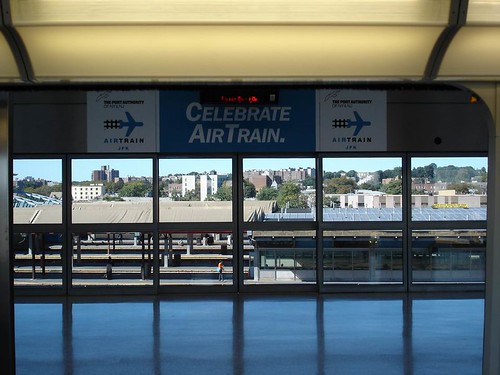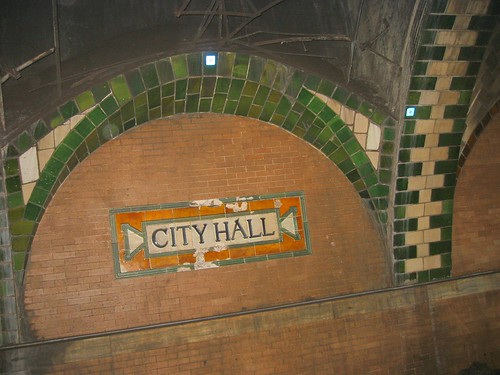
You can’t really make the train come faster by peering down the tracks if there’s a glass wall in the way, now, can you? (Courtesy of flickr user j&c)
The Peer is a time-honored New York City subway tradition. As the train never shows up, frustrated would-be straphangers peer into the darkness of the tunnel for a glimpse – any glimpse – of the tell-tale signs of headlights from an approaching train. According to legend, peering into the tunnel actually makes the trains come faster as well.
But the MTA wants to do away with the open tracks of the current subway system. Instead, they want the city subway’s to become AirTrain-like platforms encased in glass with sliding doors that will open when the trains arrive. William Neuman, The Times’ MTA reporter, has more:
The doors, set into a wall of glass or metal, would create a floor-to-ceiling barrier, sealing off the track and tunnel area from the platforms and altering forever the daily experience of waiting passengers. Gone would be the rush of air and thunder, gone the visceral thrill as many tons of steel hurtle by at high speed, just inches away, all replaced by the hygienic interface of technology…
The doors, he said, could allow substantial energy savings in the station cooling systems, which would use cold water to chill air blown into the stations and reduce temperatures by about 10 degrees. With open platforms, the hot air from the tunnels would mix with the cooled air in the stations. With doors on the platform edge, the heat from the tunnels would be at least partly blocked and the cooling system could operate more efficiently.
Ernest Tollerson, the MTA’s policy director, talks a lot about the environmental benefits of these doors. Additionally, as The Times’ Empire Blog notes, the doors would prevent riders from rat-observing, trash-tossing and wallet-retrieving as well. (Of course, you wouldn’t be able to drop your wallet with the doors closed, but that’s besides the point.)
On the surface, it seems like a good idea. Saving energy is a desirable goal and keeping the tracks clean is a benefit too. But all is not well.
First, how long would it take for scratchiti to overtake these doors? Second, from what I’ve read so far in the Second Ave. Subway environmental impact statement, the trains may not all be the same length. Will they have doors spaced appropriately to accommodate both the 60-foot- and 75-foot-long cars? That sounds like an engineering nightmare to me.
And how about that bugaboo of any MTA project, the cost? Mysore Nagaraja, the head of capital construction for the MTA, is tight-lipped about the dollars, saying the doors would just be added to the project’s total budget.
But former MTA head Lawrence Reuter shared his views on the doors, and it’s not a favorable one. “I definitely discouraged it because it’s a cost item and it’s a maintenance item,” Reuter said. “It’s only going to apply in a few stations. What good is it going to do if you can’t adapt it to the rest of the system? I didn’t see any benefit, plus it’s going to cost extra money to maintain them.”





 If you’re on the A or C line in Brooklyn, everything is messed up this weekend. The MTA has to replace a 71-year-old piece of railbed, and that means
If you’re on the A or C line in Brooklyn, everything is messed up this weekend. The MTA has to replace a 71-year-old piece of railbed, and that means  For the last 11 months, New York City Transit has been under the leadership of interim president Millard “Butch” Seay. Since Lawrence “I have no nickname” Reuter stepped down last April, no permanent replacement had been named. But now reports say that MTA CEO Elliot “Lee” Sander is ready to name a new NYCT head.
For the last 11 months, New York City Transit has been under the leadership of interim president Millard “Butch” Seay. Since Lawrence “I have no nickname” Reuter stepped down last April, no permanent replacement had been named. But now reports say that MTA CEO Elliot “Lee” Sander is ready to name a new NYCT head. Remember away back in November when MTA Chairman Peter Kalikow
Remember away back in November when MTA Chairman Peter Kalikow 